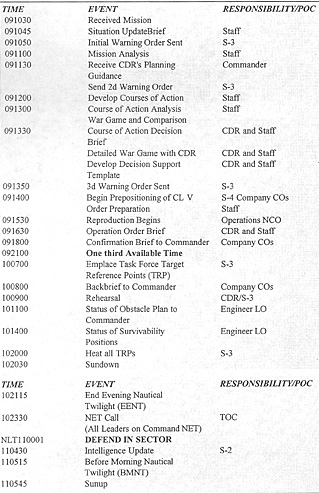
Mission Analysis and Restated Mission
OBSERVATION-
Commanders must analyze the mission completely.
DISCUSSION:
Commanders must completely analyze their mission or the result will be a poorly restated mission, an incomplete commander's intent, and a vague appreciation of available time. To help the commander analyze and restate the mission quickly, the staff begins analysis as soon as the order is received. When the operations order arrives, the executive officer (XO) distributes the portion of the order that applies to each staff officer's functional area. The staff assists the commander by identifying constraints, restrictions and specified and implied tasks contained in their portion of the order.
The XO assembles the staff and lists all the constraints, restrictions, and specified and implied tasks, once the staff has completed its analysis. While the staff compiles the list, they discuss their individual analysis to identify information from one staff officer's functional area of responsibility that will impact on another staff officer's functional area of responsibility.
The commander analyzes the commanders' intent two echelons higher and then reviews the staffs list to confirm his own appreciation of the order. The commander reviews the list and identifies the essential tasks, which define mission success, and includes them in the restated mission. The restated mission contains the elements of what, when, where, and why the unit will execute.
 In the absence of the commander, the XO leads the staff by analyzing the higher commanders' intent and collecting the constraints, restrictions, and specified and implied tasks as he would with the commander. The XO, together with the staff, drafts a restated mission and presents it to the commander when he arrives. The commander then accepts or changes the mission statement which becomes paragraph 2 in the operations order.
In the absence of the commander, the XO leads the staff by analyzing the higher commanders' intent and collecting the constraints, restrictions, and specified and implied tasks as he would with the commander. The XO, together with the staff, drafts a restated mission and presents it to the commander when he arrives. The commander then accepts or changes the mission statement which becomes paragraph 2 in the operations order.
MISSION ANALYSIS CHARTS HELP THE COMMANDER AND STAFF ANALYZE AND RESTATE THE MISSION
LESSONS:
- Staff: Assist the commander by identifying and listing constraints, restrictions, and specified and implied tasks.
- Commander: Analyze the mission completely by accomplishing the following: ;
- Review the commanders' intent of the two higher echelons.
- Identify the unit's constraints and restrictions.
- Identify the unit's specified and implied tasks.
- Derive the essential tasks from the specified and implied tasks.
COMMANDER'S PLANNING GUIDANCE
OBSERVATION:
Commanders must provide sufficient planning guidance for their staffs to develop estimates and feasible courses of action.
"Poor execution can render the most brilliant concept null and void, but the most magnificent execution can rarely offset the deadweight of a flawed concept."
- --GEN W. E. DEPUY, USA, RETIRED
DISCUSSION:
To correctly provide planning guidance, the commander must give the staff his vision of the operation. The commander develops his guidance using his experience and the information available on the mission. By training his staff, the commander learns how explicit his guidance must be. He determines the detail of guidance by evaluating the staffs abilities and the time available to plan the mission. The commander does not want to make his guidance so explicit that he suppresses the staffs ideas but focuses their efforts to quickly develop planning options.
However specific the commander's planning guidance is, he must provide his staff these nine elements.
- Enemy courses of action.
- Restated mission.
- Commander's intent.
- The concept of the operation, using the elements of the battlefield framework (area of operation, battle space and organizing the battlefield).
- The deception objective.
- Priorities.
- The time plan, produced from the commander's and staffs analysis of available time.
- The type of order to issue.
- The type of rehearsal to conduct.
Through training, the commander determines how explicit he must make his planning guidance. Regardless of the amount of commander's guidance, the staff must be prepared to receive and retain all the details. A technique for the commander to help his staff retain all his guidance is to sketch the initial concept of the operation graphics. The commander uses the sketch to explain his guidance on the scheme of maneuver, deception objective, and to designate the sustainment priorities. Additionally, a member of the staff takes notes and lists each guideline the commander gives the staff. Whether the commander remains or leaves after he gives his planning guidance, the sketch and list will assist the staff during the estimate process.
 A common mistake of commanders is believing that the staff understands his planning guidance, when, in fact, they do not. Even if the commander provides a sketch, a supplemental technique is to have the staff back-brief him on his planning guidance. Similar to having subordinate commanders back-brief him on the operations order, the commander has the staff repeat his guidance as it pertains to them. This additional technique may not always be necessary, but during the fatigue of continuous operations, it helps the commander confirm his guidance is understood. Time spent here will improve the probability that the commander will accept the staffs work later.
A common mistake of commanders is believing that the staff understands his planning guidance, when, in fact, they do not. Even if the commander provides a sketch, a supplemental technique is to have the staff back-brief him on his planning guidance. Similar to having subordinate commanders back-brief him on the operations order, the commander has the staff repeat his guidance as it pertains to them. This additional technique may not always be necessary, but during the fatigue of continuous operations, it helps the commander confirm his guidance is understood. Time spent here will improve the probability that the commander will accept the staffs work later.
LESSONS:
- Commander: Determine the amount of planning guidance the staff requires to develop the plan.
- Commander: Do not suppress the staffs ability to plan by providing excessive planning guidance.
- Commander: Sketch the initial concept of the operation for the staff.
- Staff: Take notes on the commander's guidance.
- Commander: Have the staff back-brief you on your guidance.
 TIME MANAGEMENT
TIME MANAGEMENT
"You can ask me for anything you like, except time."
- --NAPOLEON
OBSERVATION
Commanders and staffs must analyze and plan the use of available time in detail and not waste planning and preparation time.
At right, example of detailed timeline.
DISCUSSION:
A significant problem commanders and staffs face during the MDMP is time management. Though time is very valuable, it is often wasted by poor management leaving little time for effective preparation. To have time to accomplish all the tasks during preparation, commanders and staffs must organize, plan and manage their available time. Identified as part of the commander's planning guidance, the analysis of time begins as the mission is received. Once the commander receives his mission, he begins a METT-T analysis including an analysis of time.
Problems begin when the commander's, or commander's and staffs, analysis consists only of determining their planning time (one-third available time). This is only a partial analysis and does not enable the commander to determine how much time he has to conduct each step of the MDMP or prepare for mission execution. Using the "one-third or one-fifth" rules to manage time only serves to determine the impact on subordinate commanders' time, which is necessary, because only the commander can preserve subordinate commanders' time.
A technique to efficiently analyze and manage time is to develop a planning and preparation timeline which becomes part of the time plan. The timeline identifies the time for planning and preparation tasks, beginning when the unit receives the mission and ending when the unit executes the mission. During planning, the commander and staff develop and refine the timeline by listing the tasks they will conduct or must track.
By developing the timeline, the commander has an appreciation of the amount of time available for him and his subordinate commanders. The timeline shows the commander and staff using 10 1/2 hours (from mission receipt to end of order plus briefback and rehearsal time) of the available 37 1/2 hours, providing the majority of available time to subordinates for planning and preparation.
Beginning with receipt of the mission, the staff develops an initial timeline, identifying on a chart the times for known events using the reverse planning sequence. At this point, all that can be listed is mission receipt time, mission execution time, the one-third time point (planning time), and light data.
The XO continues to develop the timeline by identifying the estimated time the staff will assemble to prepare their situation updates, analyze the mission, and brief the commander. 'To develop the timeline further, the commander and staff need to know how long it takes to conduct each planning task. This information is obtained only by training on the MDMP. The commander determines the amount of time the staff will spend on course of action analysis, wargaming and the time of the decision brief These events are added to the timeline so the staff can plan their own time while developing their estimates.
The commander and staff identify tasks to be accomplished during preparation, while they develop the plan. These tasks are added to the timeline with the responsible person or organization. The TOC then tracks the status of the task for the commander. By adding preparation tasks to the timeline, the commander and staff can synchronize the preparation effort.
LESSONS:
- Commander: Preserve subordinate commanders' time.
- Commander and staff: Develop a planning and preparation timeline.
- Commander and staff: Refine the timeline by listing tasks to be accomplished during planning and preparation and the person responsible to complete the task.
- Commander and staff: Use the timeline to track the progression of preparation.
Back to Table of Contents -- Battalion and Brigade Battle Staff
Back to CALL List of Issues
Back to MagWeb Magazine List
© Copyright 2004 by Coalition Web. Inc.
This article appears in MagWeb.com (Magazine Web) on the Internet World Wide Web.
Other articles from military history and related magazines are available at http://www.magweb.com